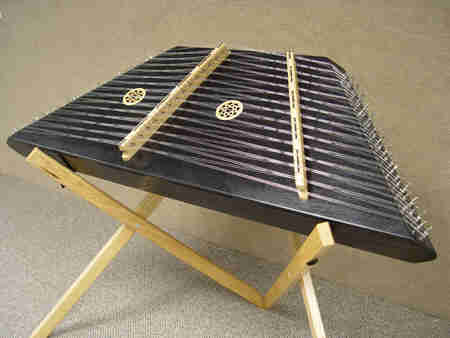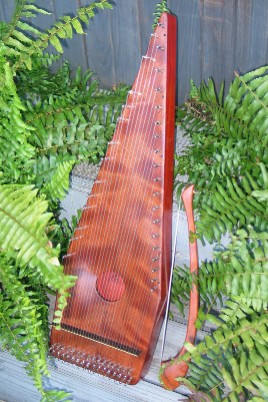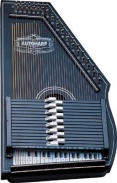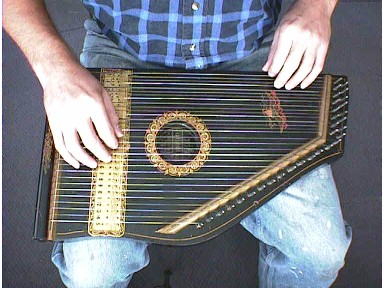|

Hammered Dulcimer
(portions taken from www.hobgoblin-usa.com)
The hammered dulcimer is a large, many-stringed instrument that is played
by hitting the strings with hammers. It is believed ot have originated in the mid-eastern region of the world before Biblical
times. The name "dulcimer" is mentioned in the Bible in Daniel 3:5 (KJV). Similar instruments are found in other
cultures such as China. It also has a strong history in the English
and Celtic traditions.
The Hammered Dulcimer is a diatonic instrument, and the scales available go
round the circle of 5ths. The diatonic scale is played by hitting the first 4 strings on the bass side, then switching to
the first 4 on the treble side for the next 4 notes of the scale. If the lowest scale is A starting with the first course,
then the D scale will start on the 4th course (the 4th note of the A scale), again using the first 4 notes on the bass (right)
then switching to the treble (left) side. And so on with the scale of G, C and maybe even F.
The range of the dulcimer is up to 3 octaves usually from D to D''' on a 29
course instrument. This gives the diatonic keys of A, D, G and C.
(portions taken from www.hobgoblin-usa.com and www.stapletonwoodcrafts.com)
The history of the bowed psaltery is unclear. Some music historians
claim the instrument dates back to the Hellenistic or Renaissance periods. Others claim it dates back to Biblical times.
Although the instrument does appear to be something characteristic of the Renaissance the most generally accepted theories
place the origin of the bowed psaltery during the late 1800s or early 1900s. Its design is often credited to a German music
teacher who used it as a simple instrument for beginning music students to learn.

|
| Built by Steven Stapleton |
It has been suggested that the psaltery, like the lute, came to the courts
of Europe with Crusaders returning from the Holy Land. A comparison between European Psalteries and Persian Santirs or Arabian
Kanums reveals a likely connection. Although this explanation seems to be well founded and the most widely accepted, two other
possibilities exist. The psaltery was well known in Classical Greece and could easily have been brought to Europe by the conquering
Romans along with the many other items of Greek culture which they avidly acquired. Earlier still, the Phoenicians traded
all over the Mediterranean and along the Atlantic and North Sea coastlines of Europe. It is not beyond the bounds of possibility
that psalteries were amongst the items traded by the Phoenicians for Cornish tin.
Psalteries declined in popularity as court instruments in the later Middle
Ages in favour of virginals and spinets. Like many other medieval instruments, however, the psaltery did not die out, but
continued as a folk instrument passed down, in some versions completely unaltered to the present time.
Bowed Psalteries are triangular in shape with the stings arranged in a manner that permits
each string to be bowed separately thus creating the individual notes of a melody. A form of the zither, the strings run from
pegs at the base of the instrument to pegs arranged along the side. Set up much like a piano, the notes on the right side
of the instrument are tuned like the white keys and those on the left side, the sharps and flats, are tuned like the black
keys. Unlike a violin, each string of the bowed psaltery is tuned to a different note so one does not need to finger or fret
the strings when playing. Notes played on the bowed psaltery continue to ring after being played, giving this instrument a
very haunting and distinctive sound. Most bowed psalteries have 24 strings and a two octave range. The bow is usually
made with horse hair and rosined to create sound when it is pulled or pushed over the stings.
The name "autoharp" is a trademark of the Oscar Schmidt Company. Other
instruments by other manufacturers look and operate in the same manner, but only instruments manufactured by Oscar Schmidt
Company can carry the name "autoharp."
The autoharp is based on the fretless zither which is discussed below.
Oscar Schmidt and Frederick Menzenhaur who patented the fretless zither were business partners.

The autoharp has strings similar to the fretless zither, but includes bars
with pads that damp certain strings to form chords on the strings that are unmuted. The buttons on the bars are
labeled with the chord names so that the player can easily see which buttons to push to produce a particular chord.
It is usually strummed but can also be plucked.
The autoharp made playing easy and was sold through the Sears and Roebuck
catalog. Its simplicity, ready availability and low cost made it a popular instrument among country people in the
early 1900s.
The Oscar Schmidt Company continues today as one of the most popular builders
of the autoharp.
Strings for the autoharp are very expensive. The reason is that they are
only available in expensive sets. All of the wound strings have an unwound bit at each end, so standard strings
cannot be used to replace them since they must be specially made. The unwound strings, however, can be replaced with
guitar strings of the correct gauge.
Click the link below to hear Kelly Williams play the fretless zither:
Fretless Zither
Friederich Menzenhauer
was the father of the guitar-zither in the United States. He was granted the first patent,
whose date is shown on instruments made by various manufacturers. Menzenhauer
was born in Magdeburg Germany on January 3, 1858, and traveled to the U.S. on the ship Hohenstauffern from Bremen, arriving
in New York on May 8, 1882.

By 1887 he was living in Jersey City, NJ, and was known as a maker of musical
instruments. His first patent was issued that year for a "Tremolo Attachment for Cornets," a wind-up device which oscillated
a valve in the tube of the horn. His next patent was issued soon after with a similar title, but was a bit more like a "whammy
bar" in execution.
In 1892 he married Wilhelmina Geibel, who was born in New York in 1860.
The period of zither development came after 1860. The widely-cited first guitar-zither
patent was issued on May 29, 1894. In September, 1895, he received a patent for a "Metallophone Zither", which had chord groups
for accompaniment, but played the melody on xylophone bars. At the end of 1896, the Menzenhauer Guitar Zither Co. leased a
two-story tin-roofed building in Jersey City. In January 1897, he received a patent for a "Harp Cithern," an odd combination
of harp and guitar-zither.
Their only child, Theodore, was born in June, 1897.
In October of 1897, he and Oscar Schmidt were doing business as the U.S. Guitar-Zither
Co., which may have been a distributing arm of their organization.
By 1898, he was also doing business as the Menzenhauer Guitar-Zither Co.,
and the operation was located on Ferry Street in Jersey City, the site of Oscar Schmidt International until 1972. Much of
this factory building was in place in 1895, but it is unclear exactly when Menzenhauer obtained this property. Early on, the
location was known as 34-41 Ferry Street, the numbers of the lots on the survey of land by the Holland Co. By 1902 the location
had received the street addresses 87-101, which the townhouses on those lots still hold today.
In September 1899, he received the first two patents describing what became
known as the mandolin-guitar-zither. The next patent, dated June 1900, for an attachment to this instrument, was assigned
to Menzenhauer & Schmidt, which was the name of the business around 1900-1901.
At this point, there appears to have been some problem between the partners.
On May 7, 1900, Menzenhauer transferred the Ferry Street property to Oscar Schmidt for $1. And then he disappeared from the
Jersey City directory until 1904.
In 1904, he had moved into the house at 22 Sherman Place, where he spent the
rest of his life. He was still tinkering with musical instruments, and he started receiving patents again. In 1910, the patent
was for a modification of the Mandolin-guitar-zither which used a small key mechanism. In 1911 he patented a playing action
which used keys similar in appearance to piano keys. In 1914 he received a patent for a melody-playing action that was eerily
reminiscent of the Celestaphone, but with the hammers reversed. His final patent was issued in 1917, for a chord-playing mechanism
that allowed separation between the bass string and the remaining three strings of the chord.
Menzenhauer was apparently more of an engineer than a businessman. His penchant
for tinkering continued. In 1918 he was involved with the ice company, and he developed a scheme to remove impurities from
the center of ice blocks.
Frederick Menzenhauer passed away on March 1, 1937, leaving a widow, son,
and grandson.
Manufacturers Advertising Company was an alias that was used for many years by the Oscar Schmidt-International Corp. The address was always the
same as the actual company.
|




